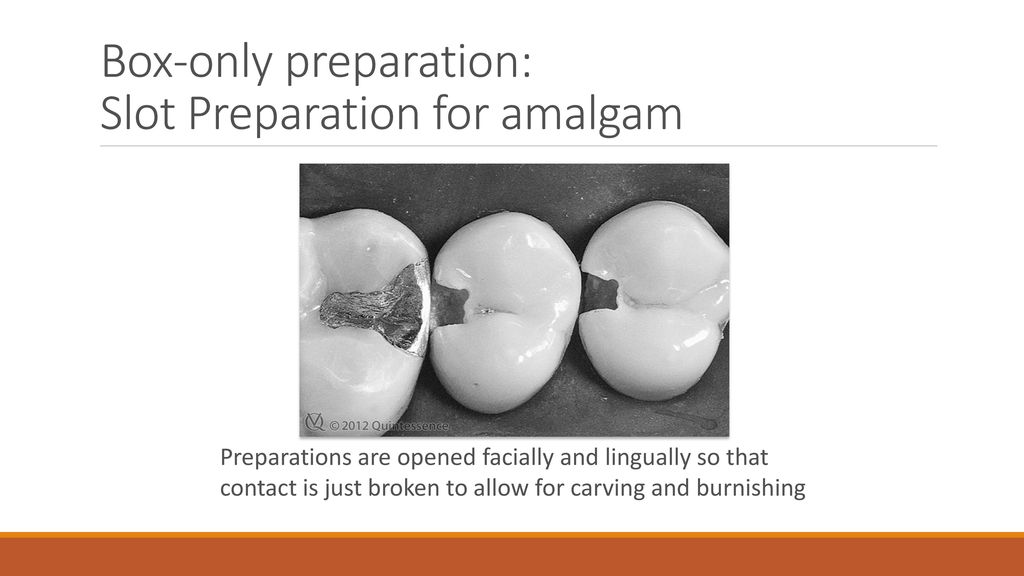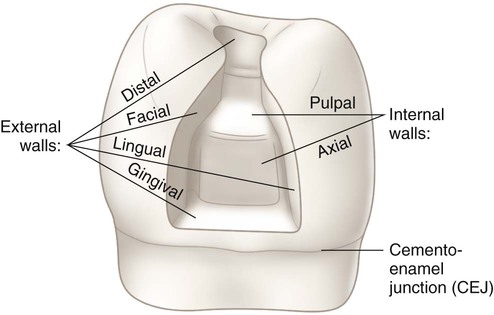OUTLINE FORM:
G .V. Black has described the outline form as being “the form of the area of the tooth surface to be included within the outline or enamel margins of the finished cavity”. It is the placement of cavity margins in the positions they will occupy in the final preparation, except for finishing enamel walls and margins and preparing an initial depth of 0.2 – 0.8mm pulpally of DEJ or normal root surface position.
Two outline forms can be appreciated
- External outline form-which dictates the external perimeter of the outline form.
- Internal outline form-which dictates the inner dimension and detail of the cavity.
These may or may not be included in an actual appointment book. These slots are prep and seating, dismissal of the patient, and disinfection of the operatory. The dental assistant is primarily responsible for these required functions. Operatory appointment booking. Dental floss will not remove plaque from within the cavity. The restoration seeks to restore the integrity of the tooth. The slot prep was compared and found to be a more reliable alternative.
The factors that determine outline form are the following:
- Extent of the carious lesion.
- Extend the cavity margin until sound tooth structures obtained and no unsupported enamel remains.
- Margins should be paced in easily cleansable areas.
- Average depth of the cavity should be 0.5 mm into dentin.
- Extend the cavity margins into fissures that cannot be eliminated by appropriate enameloplasty.
PIT AND FISSURE CAVITIES
- The general factors mentioned above are to be followed. In addition the following are considered:
- Avoid terminating the margin on extreme eminences such as cusp heights and ridge crests.
- Circumventing of cusps should be followed resulting in a smooth free flowing outline form.
- In case of conservative cavity preparation shallow supplemental grooves and fissure crossing lingual or facial ridge can be eliminated by enameloplasty.
- When two pit and fissure cavities have been separated by less than 0.5 mm of sound tooth structure, they should be joined to eliminate a weak enamel wall between them.
PROXIMAL SMOOTH SURFACE CAVITIES
Occlusal cavity outline is same as above.
Gingival margins
Slot Prep Dental
According to G.V.Black’s concept the gingival margin should be placed 0.5 to 1.0 mm apical to the crest of healthy free gingival. Because this area was thought to be sterile due to the alkalinity of crevicular fluid and less chances of food impaction in this area, moreover the knife edge relationship of the healthy free gingival to the adjacent tooth surface will discourage food accumulation on the adjacent restored surface occlusal to the sulcus for considerable periods during and after food ingestion. But, Dr. John Me Call has shown that mechanical causes, systemic conditions and traumatic occlusion change the alkalinity of the crevicular fluid to an acidic form making it more prone to aciduric environment.

Emphasis is made to place the margin occlusal to or just clear of the margin of the gingival crest.
Facial margin and lingual margin
The following factors govern them:
- Flare and mesiodistal width of embrasures.
- Wider and more flared the faciolingual embrasures are, less are the chances of food accumulation and therefore requires less extension facially and lingually.
- Caries index and oral hygiene.
- Faciolingual extension of the cavity in the corresponding embrasure is directly proportional to the caries index.
- Occlusal and masticatory forces.
- The more ideal the relationship between the adjacent and opposing teeth is, the better is the cleansability of the facial and lingual embrasures. Therefore, less extension is required.
- Age of patient and tooth structure and attrition of contact areas.
- An older tooth has higher fluoride content, is more resistant to caries and requires less extension.
- Creation of a more convex restoration.
- More convex restorations lead to wider embrasures and therefore less extension and better self cleansable areas.
Gingival margin is placed as in class II cavities. In young patients the margin is covered by the gingival whereas in patients with gingival recession the margins are kept supragingival. The mesiodistal extension is obtained considering the occluso-gingival convexity, occlusion and masticatory forces, caries index, and age of the patient.
Occlusal extension should not include the height of contour of facial and lingual surfaces.
MODIFICATIONS DUE TO THE TYPE OF RESTORATIVE MATERIAL
AMALGAM:
With the introduction of modern alloys, the modern concept of cavity preparation can be compared to the conventional G V Black’s design which are less time consuming, conserving and with decreased chances of failure.
CONVENTIONAL
OCCLUSAL PORTION- extension for prevention, mortise shaped with definite line angles and point angles.
PROXIMAL PORTION– either box type or truncated cone.
ISTHMUS-will not exceed 1/3rd intercuspal distance, atleast 1.5mm.
SWEEPING CURVES-given to the proximal and occlusal walls where they meet.
ACCESSORY RETENTION– proximal grooves are not so critical.
MODERN
OCCLUSAL PORTION:
- More conservative approach. Here G V Black’s concept of extension for prevention does not apply.
- Going around the cusps to conserve tooth structure.
- Not extending the facial and lingual more than midway between the central grooves and cusp tips.
- Using enameloplasty on the terminal ends of shallow fissures to conserve tooth structure.
- Margins of the facial and lingual class I involve the entire facial and lingual groove to avoid feather edged marginal amalgam.
PROXIMAL PORTION:
Only a unilateral inverted truncated cone on functional side of marginal angles to preserve tooth structure. The gingival margin should be located occlusal to the height of contour.
ISTHMUS:
Not to exceed 1/4th intercuspal distance.
SWEEPING CURVES:
Universal sweeping curve is exaggerated and more bulk is accommodated.
ACCESSORY RETENTION:
Proximal grooves are used more often due to limited occlusal width.
TOOTH COLORED RESTORATIONS
Emphasis is more on conservative tooth preparation. G.V.Black’s concept of “extension for prevention” does not apply. With the introduction of acid etching phenomena by Buonocore, coupled with the use of synthetic resins has revolutionized the concept of cavity design.
Butt joint marginal configuration and placement of floor in dentin for retention were the characteristic features of conventional method. The modern concept is to include all faulty areas and conserve more tooth structure. Floor is not routinely placed in dentin. It depends on the caries extent and depth. Bevel is given on the enamel cavosurface margin. As in the conventional types, when a butt joint is made, a white halo is seen after the restoration is complete. This can be avoided by beveling the margin.
The ends of the enamel rods are more effectively etched than when only the sides are exposed to the etchant.
In case of composite resins the contact area should be maintained, left untouched as this material cannot maintain contact integrity, these materials can accommodate undermined enamel as long as it is not carious, discolored directly loaded in centric or eccentric contact or cracked.
CAST GOLD RESTORATION
The main characteristic feature in these restorations is taper and bevel incorporation in the outline form. The gingival to occlusal divergence of these cavity walls may range from 2 to 5 degree taper on each wall. The taper should be minimum in shallow cavities for better retention and resistance. The taper should be more in deep cavities for proper seating of the restoration. The taper prevents the undisturbed withdrawal of the wax pattern and subsequent seating of the casting.
Slot Prep Dental

Resistance form may be defined as that shape and form of cavity walls that best enable both the restoration and the tooth to withstand occlusal forces without fracture.
Fundamental principles involved are:
Slot Prep In Dentistry
- Box shape or mortise shaped with flat floor, which helps the tooth to resist occlusal loading by virtue of being at right angles to the forces of mastication.
- Slightly curved than acute line angles decrease the stress concentration of stresses and hence reduce the incidence of fracture.
- Conservation of strong cusps and ridges with sufficient dentin support. Weakened areas should be included in cavity preparation to prevent fractures (capping of the weakened cusps).
- To provide enough thickness of restorative material to prevent fracture under load.
- Slight roundening of the line angles to prevent stress concentration.
Slot Preparation Dentistry
STRESS PATTERNS OF TEETH
According to Gabel application of mechanical principles to the design of restorations will help conceive favorable stress patterns for the teeth and the restorations. These principles vary according to the type of restoration and cavity.
TYPE OF RESTORATION:
Slot Prep Dental
The minimal thickness of amalgam and cast gold to resist fracture is approximately 1.5mm, though a little more depth is required for amalgam to achieve the requisite bulk. However in composite and glass ionomer, the depth is not the criteria for achieving resistance form. Porcelain also requires a depth of 2mm for inlays and 1.5mm for crowns.

TYPE OF CAVITY:
CLASS I:
A flat pulpal floor is appropriate. In case of deep caries where a rounded pulpal floor may result, the stress is doubled in the deepest portion of the cavity. Fractures in these rezsstorations are due to insufficient dentinal thickness in the center. Bending stresses are proportional to square of depth. Therefore for large restorations depth should be increased with increase in diameter.
CLASS II:
A proximo-occlusal inlay restoration acts like a curved beam of cantilever type. Due to differences in modulus of elasticity of dentin and the material there will be displacement of the restoration in the gingival seat area with the axio-pulpal line angle as axis of restoration. This is prevented by a lock in the form of groove pins, etc in the gingival floor. In M.O.D. cavity axio-pulpal line angle should be more rounded.
CLASS III:
Due to the thickness of incisal edge the cavity is extended lingually as close to the incisal edge as possible.

CLASS V:
The functional cusp and functional fossa relationship dictates the stress pattern.
EFFECT OF GROOVES:
Grooves provide resistance to a certain degree. Courdadee and Jimmerman have shown that localized areas of stress are produced in tooth tissue by provision of supplemental intracoronal retention in the form of pins.